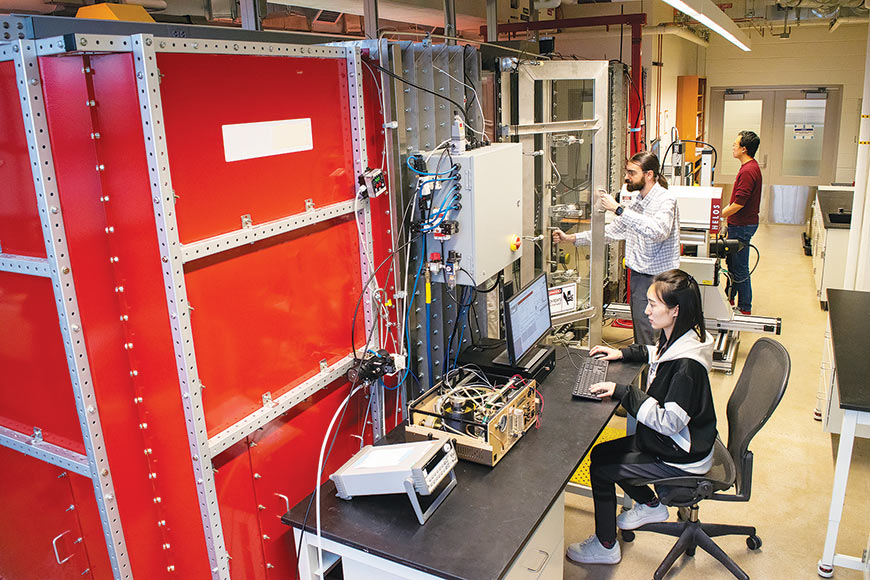Wind Tunnel Will Enhance University of Minnesota Research

A donation from WinField United will enable aerosol researchers at the University of Minnesota College of Science and Engineering (CSE) to study what’s blowin’ in the wind. And then use that knowledge to help farmers.
A large wind tunnel once housed at the former WinField United Product Development Center in River Falls, Wisconsin, is now ready to rev up at the Aerosol Diagnostics Laboratory on the university’s Minneapolis campus. The tunnel will be formally presented at a ceremony on November 16.
The tunnel played a major role in our breakthrough product research for many years. However, the new WinField United Innovation Center (opened in 2017) required an upgraded wind tunnel designed for the high throughput demanded by our product development process. This prompted us to see if the University of Minnesota was interested in acquiring our existing wind tunnel and using it for agricultural product research.
As a graduate of the CSE and having served as an undergraduate research assistant in the aerosol research department, I realized how beneficial this technology will be.
Using aerosol research to fuel ag progress
The aerosol research group of the Department of Mechanical Engineering, founded in the 1950s, is one of the leading centers of small-particle research in the United States. Aerosol research is the study of how particulate matter moves through the air. Our work, which uses active ingredients with various spray nozzles and in multiple tank mixes, has enabled WinField United to develop considerable expertise in understanding the potential for spray drift of agricultural products.
Research at the Aerosol Diagnostics Laboratory will help validate and inform our activities at the Innovation Center and vice versa. WinField United and the University of Minnesota will collaborate and share learnings, and expand knowledge about spray drift in the agricultural industry.
One area of specific exploration may be dicamba drift. At WinField United, we’ve already begun to examine this issue and the use of drift reduction agents. This new partnership gives us another avenue to help tackle this problem. Examining droplet size more closely might be one way to begin to offer some answers to dicamba drift.
Pursuing the unexpected
WinField United sought out the CSE to make a connection with a discipline of science that is distinct from agriculture. We wanted partner with the experts on spray drift and particulate movement in the atmosphere.
There are numerous scientific disciplines in the CSE that WinField United could tap into. These include soil health, residual effects of herbicides, movement of pesticides through the soil layer and runoff of crop protection products into waterways. This partnership is a way for our company to bring more subject matter experts into agriculture to offer fresh perspectives on making our industry better for farmers and more sustainable for everyone.
A large wind tunnel once housed at the former WinField United Product Development Center in River Falls, Wisconsin, is now ready to rev up at the Aerosol Diagnostics Laboratory on the university’s Minneapolis campus. The tunnel will be formally presented at a ceremony on November 16.
The tunnel played a major role in our breakthrough product research for many years. However, the new WinField United Innovation Center (opened in 2017) required an upgraded wind tunnel designed for the high throughput demanded by our product development process. This prompted us to see if the University of Minnesota was interested in acquiring our existing wind tunnel and using it for agricultural product research.
As a graduate of the CSE and having served as an undergraduate research assistant in the aerosol research department, I realized how beneficial this technology will be.
Using aerosol research to fuel ag progress
The aerosol research group of the Department of Mechanical Engineering, founded in the 1950s, is one of the leading centers of small-particle research in the United States. Aerosol research is the study of how particulate matter moves through the air. Our work, which uses active ingredients with various spray nozzles and in multiple tank mixes, has enabled WinField United to develop considerable expertise in understanding the potential for spray drift of agricultural products.
Research at the Aerosol Diagnostics Laboratory will help validate and inform our activities at the Innovation Center and vice versa. WinField United and the University of Minnesota will collaborate and share learnings, and expand knowledge about spray drift in the agricultural industry.
One area of specific exploration may be dicamba drift. At WinField United, we’ve already begun to examine this issue and the use of drift reduction agents. This new partnership gives us another avenue to help tackle this problem. Examining droplet size more closely might be one way to begin to offer some answers to dicamba drift.
Pursuing the unexpected
WinField United sought out the CSE to make a connection with a discipline of science that is distinct from agriculture. We wanted partner with the experts on spray drift and particulate movement in the atmosphere.
There are numerous scientific disciplines in the CSE that WinField United could tap into. These include soil health, residual effects of herbicides, movement of pesticides through the soil layer and runoff of crop protection products into waterways. This partnership is a way for our company to bring more subject matter experts into agriculture to offer fresh perspectives on making our industry better for farmers and more sustainable for everyone.


